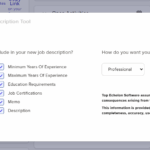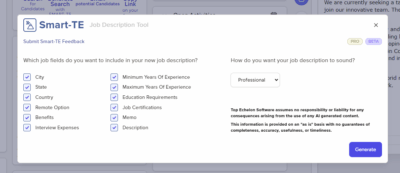Recruitment has always been a people-centric industry. The success of agency recruiters and search consultants hinges on their ability to build relationships with candidates, understand their motivations, and match them with roles where they will thrive. However, the time-consuming nature of administrative tasks—such as scheduling interviews, processing resumes, and tracking communication—often gets in the way of fostering those personal connections.
Enter recruiting software automation. By automating repetitive, low-value tasks, recruiting software empowers recruiters to focus more of their time and energy on the human side of recruitment. From sourcing candidates and managing communications to nurturing relationships and making strategic decisions, automation transforms the way agencies operate, making them more efficient, competitive, and candidate-focused.
In this article from Top Echelon Recruiting Software, we’ll explore how recruiting software automation can help agency recruiters and search consultants free up time to focus on their core mission: building relationships with candidates. We’ll also highlight the key tasks that can be automated, the benefits of doing so, and best practices for implementing automation in your recruiting process.
The Time-Consuming Nature of Traditional Recruiting
Before we delve into the benefits of automation, it’s important to understand the challenges recruiters face when managing high volumes of candidates and job orders. Here are some common time-consuming tasks that often prevent recruiters from dedicating enough attention to candidates:
- Sourcing Candidates: Searching for candidates across multiple job boards, databases, and social media platforms is a tedious task. Manually posting job ads, sifting through resumes, and compiling candidate shortlists can eat up valuable time.
- Data Entry and Resume Parsing: Manually entering candidate information into spreadsheets or databases is a necessary but monotonous task. Without automation, this data-entry process can be slow and prone to errors.
- Interview Scheduling: Coordinating interview times between candidates, hiring managers, and other stakeholders often requires multiple back-and-forth communications, leading to scheduling conflicts and delays.
- Candidate Communication: Keeping candidates engaged throughout the recruitment process requires consistent communication. Sending updates, follow-up emails, and interview reminders manually can be overwhelming when managing a large talent pipeline.
- Tracking Candidate Progress: Monitoring where each candidate stands in the recruitment process—from initial contact and screening to interviews and offers—requires careful attention. Manually tracking progress increases the risk of errors, such as missing follow-ups or forgetting to move a candidate to the next stage.
These tasks, while essential, take recruiters away from what should be their primary focus: engaging with candidates, understanding their needs, and building long-term relationships.
How Recruiting Software Automation Can Help
Recruiting software automation allows agency recruiters to streamline and automate many of the repetitive, time-consuming tasks that often bog them down. By leveraging automation tools, recruiters can reduce administrative burdens, improve efficiency, and free up time to focus on what truly matters—finding and engaging the right talent.
Here’s how automation can revolutionize key aspects of the recruitment process:
1. Automating Candidate Sourcing and Resume Parsing
Sourcing is one of the most critical—and time-consuming—aspects of recruitment. Manually posting job openings across multiple platforms, searching databases for candidates, and screening resumes can slow down the recruitment process, making it harder to stay competitive.
How Automation Helps:
- Job Posting Automation: Recruiting software can automatically post job openings to multiple job boards, social media platforms, and internal databases with a single click. This eliminates the need for recruiters to manually post jobs on each site, saving valuable time.
- Resume Parsing: Advanced recruiting software uses AI-driven resume parsing technology to automatically extract candidate information—such as contact details, work experience, skills, and education—directly from resumes and populate candidate profiles in the system. This eliminates the need for manual data entry and ensures that profiles are created quickly and accurately.
- AI-Powered Candidate Matching: Many recruiting platforms use AI to match candidates to job descriptions based on their qualifications, experience, and skills. This automation helps recruiters generate candidate shortlists in a fraction of the time it would take to manually review resumes, ensuring that only the most relevant candidates are considered.
By automating sourcing and resume parsing, recruiters can save hours of manual effort and focus more on engaging top-tier candidates and building relationships.
2. Automating Interview Scheduling
Scheduling interviews is a logistical challenge for most recruiters. Coordinating multiple parties—candidates, hiring managers, and other stakeholders—often results in long email chains and scheduling conflicts. Manually managing these schedules can be cumbersome, especially when handling multiple job orders at once.
How Automation Helps:
- Automated Interview Scheduling: Recruiting software offers integrated calendar systems that allow candidates and hiring managers to select available time slots for interviews. The software then automatically schedules the interview and sends confirmations to all parties involved.
- Self-Scheduling Options: Some platforms allow candidates to self-schedule their interviews by choosing from available slots provided by the recruiter. This reduces the back-and-forth typically required to finalize an interview time, speeding up the process.
- Automated Reminders: Once an interview is scheduled, recruiting software can automatically send reminders to both candidates and interviewers, ensuring that no one forgets the appointment. This reduces the likelihood of missed interviews and last-minute cancellations.
By automating the interview scheduling process, recruiters can significantly reduce the time spent on coordination and minimize scheduling conflicts, allowing them to focus on preparing candidates for interviews.
3. Automating Candidate Communication
Clear and consistent communication is essential to keeping candidates engaged throughout the recruitment process. However, manually sending emails, status updates, and follow-up messages to a large volume of candidates can be overwhelming for recruiters.
How Automation Helps:
- Automated Email Campaigns: Recruiting software allows recruiters to create automated email campaigns that send personalized messages to candidates at key stages of the recruitment process. For example, automated emails can be triggered when a candidate applies for a job, moves to the next stage, or is scheduled for an interview.
- Personalization at Scale: Automation doesn’t mean sacrificing personalization. Recruiting software enables recruiters to send personalized messages at scale by dynamically inserting candidate-specific information (e.g., name, job title, company) into automated emails. This ensures that communication feels tailored, even when it’s automated.
- Automated Follow-Up Reminders: If a candidate hasn’t responded within a certain time frame, automated follow-up emails can be triggered, prompting candidates to confirm interview times or submit additional information. This ensures timely responses and keeps the process moving forward.
By automating routine communication, recruiters can maintain consistent engagement with candidates without having to manually manage every interaction, reducing the risk of losing top talent due to communication gaps.
4. Automating Candidate Progress Tracking
In a high-volume recruiting environment, tracking where each candidate stands in the recruitment pipeline can be challenging. Manually managing candidate status across spreadsheets or basic systems increases the risk of errors and inefficiencies.
How Automation Helps:
- Applicant Tracking System (ATS): A robust ATS automates the tracking of candidates throughout the recruitment process, from initial application to job offer. Recruiters can easily see where each candidate is in the pipeline, identify bottlenecks, and ensure that candidates are progressing smoothly through the hiring stages.
- Automated Status Updates: When a candidate moves from one stage of the recruitment process to the next (e.g., from screening to interview), the software automatically updates their status in the ATS. This eliminates the need for manual updates and ensures that recruiters always have the most up-to-date information.
- Visual Pipeline Management: Many recruiting platforms provide visual dashboards that allow recruiters to quickly view their candidate pipelines and see how many candidates are at each stage. This visual representation makes it easier to manage large volumes of candidates and spot potential delays.
Automating candidate progress tracking reduces administrative overhead and ensures that no candidates fall through the cracks, allowing recruiters to focus on high-priority candidates.
5. Automating Data Collection and Document Management
Collecting and managing candidate documentation, such as resumes, cover letters, references, and compliance forms, is an essential part of the recruitment process. However, manually tracking and organizing these documents can be time-consuming and prone to errors.
How Automation Helps:
- Document Upload and Storage: Recruiting software allows candidates to upload necessary documents (resumes, portfolios, references, etc.) directly through the platform. The system then automatically stores these documents in the candidate’s profile, ensuring that all necessary information is easily accessible.
- Automated Compliance Checks: In industries where background checks or compliance documents are required, recruiting software can automatically request these documents from candidates and track their completion. This ensures that all compliance requirements are met without manual oversight.
- Digital Signatures: Some recruiting platforms offer digital signature capabilities, allowing candidates to electronically sign offer letters, contracts, and other important documents. This eliminates the need for physical paperwork and speeds up the hiring process.
Automating data collection and document management not only reduces administrative burden but also ensures that recruiters have quick access to all necessary documentation for candidates and clients.
Benefits of Recruiting Software Automation
The benefits of recruiting software automation extend beyond simply saving time. Automation can have a transformative impact on your agency’s overall efficiency, candidate experience, and placement outcomes. Here’s how:
1. Increased Productivity
By automating repetitive administrative tasks, recruiters can spend more time on strategic activities, such as sourcing high-quality candidates, conducting interviews, and building relationships with both candidates and clients. This increased focus on value-added tasks improves overall productivity and allows recruiters to handle more job orders at once.
2. Faster Time-to-Fill
Automation speeds up key recruitment processes, from sourcing and screening to interview scheduling and follow-ups. With automated tools handling much of the legwork, recruiters can move candidates through the pipeline more quickly, reducing time-to-fill for open positions and improving client satisfaction.
3. Enhanced Candidate Experience
Candidates appreciate timely communication and a seamless recruitment process. By automating updates, reminders, and scheduling, recruiting software ensures that candidates stay informed and engaged throughout the process, leading to a better overall experience and increasing the likelihood of successful placements.
4. Reduced Human Error
Manual data entry, tracking, and communication are prone to human error, which can lead to missed opportunities, miscommunications, or delays. Automating these tasks reduces the risk of mistakes, ensuring a smoother and more reliable recruitment process.
5. Scalability
As your agency grows and takes on more clients and candidates, automation allows you to scale your operations without increasing your administrative workload. With the right software in place, your agency can handle higher volumes of job orders and candidates without sacrificing quality or efficiency.
Best Practices for Implementing Automation in Recruiting
While automation offers numerous benefits, it’s important to implement it thoughtfully to avoid over-reliance on technology at the expense of human interaction. Here are some best practices for incorporating automation into your recruitment process:
- Balance Automation with Personalization: Automation is designed to handle repetitive tasks, but it shouldn’t replace personal connections. Use automation to free up time for more meaningful interactions with candidates, such as phone calls, in-depth interviews, and personalized check-ins.
- Customize Automation Workflows: Tailor automation workflows to fit your specific recruitment process. For example, set up automated follow-ups for candidates who haven’t responded within a certain timeframe or create customized email templates for different stages of the hiring process.
- Test and Monitor Performance: Regularly monitor the performance of your automated processes to ensure they’re delivering the desired results. Track key metrics, such as time-to-fill, response rates, and candidate engagement, and make adjustments to your automation strategy as needed.
- Keep Candidates Informed: Automation helps ensure that candidates receive timely updates, but it’s important to keep them informed about how automation is used. For example, if you’re using automated interview scheduling, let candidates know that they can choose their interview times through a self-scheduling tool.
Conclusion
Recruiting software automation is a game-changer for agency recruiters and search consultants. By automating time-consuming tasks—such as candidate sourcing, communication, interview scheduling, and data management—recruiters can free up valuable time to focus on what truly matters: building relationships with candidates and delivering the best possible outcomes for clients.
Automation not only increases efficiency and reduces administrative burdens but also enhances the candidate experience, improves placement rates, and allows agencies to scale their operations without sacrificing quality. By strategically implementing automation, recruiters can create a more streamlined, candidate-centric recruitment process that drives long-term success for their agency.
As recruitment continues to evolve in today’s fast-paced digital landscape, embracing automation is no longer a luxury—it’s a necessity for staying competitive, productive, and focused on building meaningful relationships with top talent.








